
The Hygrophoraceae are a family of fungi in the order Agaricales. Originally conceived as containing white-spored, thick-gilled agarics, including Hygrophorus and Hygrocybe species, DNA evidence has extended the limits of the family, so it now contains not only agarics, but also basidiolichens and corticioid fungi. Species are thus diverse and are variously ectomycorrhizal, lichenized, associated with mosses, or saprotrophic. The family contains 34 genera and over 1000 species. None is of any great economic importance, though fruit bodies of some Hygrocybe and Hygrophorus species are considered edible and may be collected for sale in local markets.

Hygrocybe is a genus of agarics in the family Hygrophoraceae. Called waxcaps in English, basidiocarps are often brightly coloured and have dry to waxy caps, white spores, and smooth, ringless stems. In Europe they are characteristic of old, unimproved grasslands which are a declining habitat, making many Hygrocybe species of conservation concern. Four of these waxcap-grassland species, Hygrocybe citrinovirens, H. punicea, H. spadicea, and H. splendidissima, are assessed as globally "vulnerable" on the IUCN Red List of Threatened Species. Elsewhere waxcaps are more typically found in woodlands. Most are ground-dwelling and all are believed to be biotrophs. Around 150 species are recognized worldwide. Fruit bodies of several Hygrocybe species are considered edible and are sometimes offered for sale in local markets.
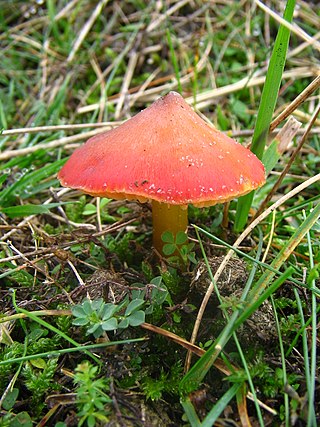
Hygrocybe conica is a species of agaric in the family Hygrophoraceae. In the UK it has been given the recommended English name of blackening waxcap, since all parts of the basidiocarp blacken with age. In North America it is commonly known as the witch's hat, conical wax cap or conical slimy cap. Hygrocybe conica is known to be a complex of at least eleven closely related species and as such is widespread in Europe, North America, Asia, and elsewhere.

Cuphophyllus is a genus of agaric fungi in the family Hygrophoraceae. Cuphophyllus species belong to a group known as waxcaps in English, sometimes also waxy caps in North America or waxgills in New Zealand. In Europe, Cuphophyllus species are typical of waxcap grasslands, a declining habitat due to changing agricultural practices. As a result, four species, Cuphophyllus atlanticus, C. colemannianus, C. lacmus, and C. lepidopus are of global conservation concern and are listed as "vulnerable" on the IUCN Red List of Threatened Species.
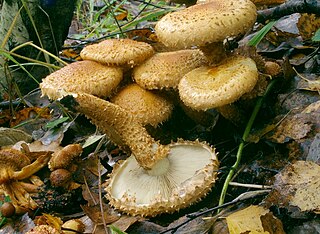
Pholiota is a genus of small to medium-sized, fleshy mushrooms in the family Strophariaceae. They are saprobes that typically live on wood. The genus has a widespread distribution, especially in temperate regions, and contains about 150 species.
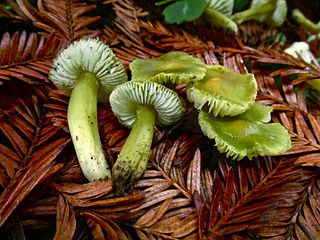
Hygrocybe virescens, commonly known as the lime-green waxy cap, is a species of agaric mushroom in the family Hygrophoraceae. The lime-green colored mushroom has a limited geographical distribution, having been reported only from California, Washington, and Mexico.

Hygrophorus agathosmus, commonly known as the gray almond waxy cap or the almond woodwax, is a species of fungus in the family Hygrophoraceae. It was first described by Elias Magnus Fries in 1815; Fries gave it its current name in 1838. A widespread species, it is distributed in the United States, Europe, Africa, and India, and is found growing under spruce and pine in mixed forests. The fruit bodies are characterized by a light grayish cap that measures up to 8 cm (3.1 in) in diameter, waxy gills, a dry stem, and the distinct odor of bitter almonds. An edible but bland-tasting mushroom, extracts of the fruit bodies have been shown in laboratory tests to have antimicrobial activity against various bacteria that are pathogenic to humans.

Cystolepiota bucknallii is a species of basidiomycete fungus of the genus Cystolepiota. Found throughout Europe, it is a rare fungus occurring in deciduous forests. The small fruit bodies bear a distinctive smell of coal gas and appear in autumn on damp ground. It is not an edible mushroom.

Hygrophorus eburneus, commonly known as the ivory waxy cap or the cowboy's handkerchief, is a species of edible mushroom in the waxgill family of fungi. It is widespread in Europe and North America, and has also been collected in northern Africa. The fruit bodies are medium-sized, pure white, and when wet are covered in a layer of slime thick enough to make the mushroom difficult to pick up. The gills are broadly attached to the stem or running down it; as the family name suggests, they feel waxy when rubbed between the fingers. Like all Hygrophorus species, the fungus is mycorrhizal—a symbiotic association whereby the underground fungal mycelia penetrate and exchange nutrients with tree roots. They are common in a variety of forest types, where they grow on the ground in thickets or grassy areas. Hygrophorus eburneus is the type species of the genus Hygrophorus. A number of biologically active chemicals have been purified from the fruit bodies of the fungus, including fatty acids with bactericidal and fungicidal activity.
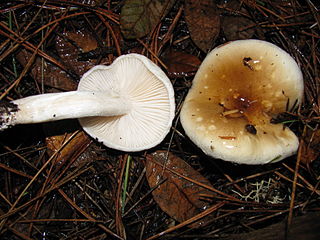
Hygrophorus bakerensis, commonly known as the Mt. Baker waxy cap, the brown almond waxy cap or the tawny almond waxy cap, is a species of fungus in the family Hygrophoraceae. It is characterized by its medium to large, relatively slender-statured fruit bodies with an almond odor, and growth often on or near rotting conifer wood. The slimy cap is brown in the center and cream to white near its curved edges. The gills and the stem are white, and in moist environments are often covered with droplets of a translucent liquid. The mushroom is known only from the United States, where it is common in coniferous forests throughout the Pacific Northwest. It was initially collected in Washington State on Mount Baker, a volcano. Although edible, the mushroom is not considered to be of high quality.

Hygrophorus purpurascens, commonly known as the purple-red waxy cap, is a species of agaric fungus in the family Hygrophoraceae. Its cap has a pink background color with streaks of purplish red overlaid, and mature gills have red spots.

Gliophorus is a genus of agaric fungi in the family Hygrophoraceae. Gliophorus species belong to a group known as waxcaps in English, sometimes also waxy caps in North America or waxgills in New Zealand. In Europe, Gliophorus species are typical of waxcap grasslands, a declining habitat due to changing agricultural practices. As a result, two species, Gliophorus europerplexus and Gliophorus reginae, are of global conservation concern and are listed as "vulnerable" on the IUCN Red List of Threatened Species.

Hygrocybe chlorophana is a species of agaric in the family Hygrophoraceae. It has been given the recommended English name of golden waxcap in the UK. The species has a largely north temperate distribution, occurring in grassland in Europe and in woodland in North America and northern Asia; it has also been reported from mountainous areas of southern Australia. It typically produces basidiocarps in the autumn. In a few European countries, H. chlorophana is of conservation concern, appearing on national red lists of threatened fungi.

Cuphophyllus pratensis is a species of agaric in the family Hygrophoraceae. It has been given the recommended English name of meadow waxcap in the UK and in North America has variously been called the meadow waxy cap, salmon waxy cap, and butter meadowcap. The species has a widespread, mainly temperate distribution, occurring in grassland in Europe and in woodland elsewhere. The basidiocarps are edible and are occasionally collected and sold commercially.

Hygrocybe quieta is a species of agaric in the family Hygrophoraceae. It has been given the recommended English name of oily waxcap in the UK. The species has a European distribution and typically occurs in grassland where it produces basidiocarps in the autumn. In several countries, H. quieta is of conservation concern, appearing on national red lists of threatened fungi.
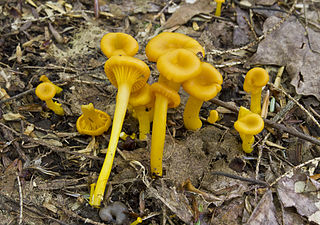
Gloioxanthomyces nitidus, commonly known as the shining waxcap, is a species of fungus in the family Hygrophoraceae. It was originally described by Miles Berkeley and Moses Ashley Curtis in 1853 as a species of Hygrophorus. The specific epithet nitidus means "shining". It was one of two species transferred to the newly created genus Gloioxanthomyces in 2013. Fruitbodies have convex, apricot-yellow to orange caps that are 1–4 cm (0.4–1.6 in) in diameter. The pale yellow, waxy gills are decurrent, with a somewhat distant spacing. Other than the gills and the base of the stipe, the bright coloring of the fruitbody fades with age. Spores are elliptical, smooth, and measure 6–10 by 4–6 µm. It is found in North America, where it grows on the ground in groups in coniferous or mixed forests. It prefers bogs, swamps, and similar moist habitats.

Hygrocybe splendidissima, is a species of agaric in the family Hygrophoraceae. It has been given the recommended English name of Splendid Waxcap. The species has a European distribution, occurring mainly in agriculturally unimproved grassland. Threats to its habitat have resulted in the species being assessed as globally "vulnerable" on the IUCN Red List of Threatened Species.
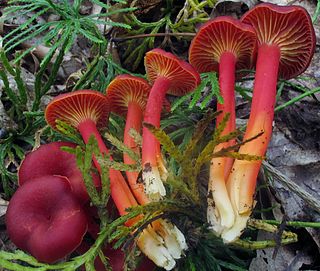
Hygrocybe appalachianensis, commonly known as the Appalachian waxy cap, is a gilled fungus of the waxcap family. It is found in the eastern United States, where it fruits singly, in groups, or clusters on the ground in deciduous and mixed forests. The species, described in 1963 from collections made in the Appalachian Mountains, was originally classified in the related genus Hygrophorus. It was transferred to Hygrocybe in 1998, in which it has been proposed as the type species of section Pseudofirmae.

Cuphophyllus canescens is a species of agaric in the family Hygrophoraceae, known from North America. In its wide sense it has been assessed as globally "vulnerable" on the IUCN Red List of Threatened Species.
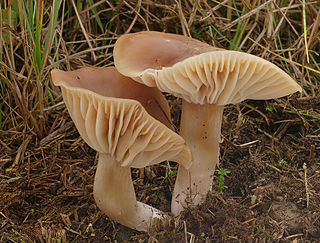
Cuphophyllus colemannianus is a species of agaric in the family Hygrophoraceae. It has been given the recommended English name of toasted waxcap. The species has a European distribution, occurring mainly in agriculturally unimproved grassland. Threats to its habitat have resulted in the species being assessed as globally "vulnerable" on the IUCN Red List of Threatened Species.

























